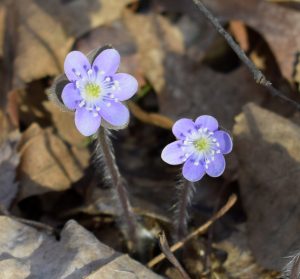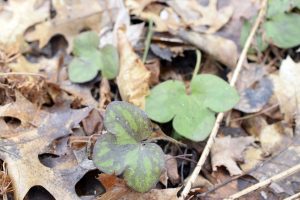Round-lobed Hepatica

Anenome americana is a spring ephemeral native to Minnesota — referred to as ephemerals because they are one of the first flowers to appear in spring with petals that won’t last long. April into May, look closely for Hepatica’s subtle spots of color peeking out from the ambers, browns and tans of last year’s leaves, and you’ll soon be noticing decorative petals where before you may have walked right past them. Hepatica sends up a single flower 1/2″ to 1″ wide on the end of a 3″ to 6″ very hairy stalk.
Like other members of the Ranunculaceae (Buttercup) family, flowers consist of petal-like sepals, not true petals. The amount varies from 5 up to 12, but there are usually 6. Color varies from violet to blue to white, sometimes pinkish. Whatever their number or color, these flowers are a welcome sight after winter’s snows melt away. They are a sure sign of spring and a delightful reminder that other spring flowers such as trillium, bellwort and anemones are on the way!
Both flower stem and leaf stalk of Hepatica are hairy, with the leaves lobed into 3 parts of similar size. Leaves protect the forming flower bud, and open up only after the flower has bloomed and wilted. At that point, the leaves come into their own through the summer, turning deep green in autumn. But wait, there’s more! One of the most interesting things about Hepatica is the persistence of the leaves through winter, staying greenish/purple under the snow until spring. They fade away at last only when new flowers emerge and new leaves form to nourish the plant through another cycle of seasons.
Look for Hepatica along the road near the Beaver Pond trail.


